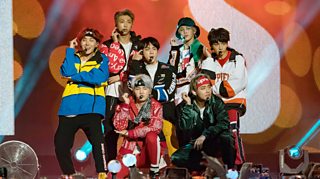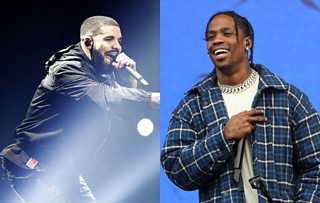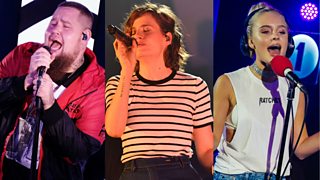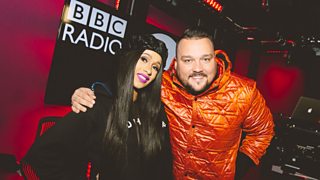Emo never dies: How the genre influenced an entire new generation

By Luke Morgan Britton, 30 May 2018
As evidenced by Panic! At The Disco's Live Lounge session this week, emo is still going strong. In fact, the genre’s influence is bigger than most give it credit for and broader than it has ever been.
Some say we’re currently experiencing an emo revival of sorts (SPIN), while others argue that it never went away in the first place (Noisey). But how did we get here? And why did recognition for the genre take so long? This is how emo went from an often scoffed-at punchline to finally getting the credit it deserves.
How it all started...
Despite what tends to spring to mind for most people, the genre’s history actually dates back a fair bit further, long before the term itself became shorthand for studded belts and box-dyed, floppy fringes. While its exact origins are debated (some claim, perhaps rather wryly, that the Beach Boys classic Pet Sounds is the first true emo album), it’s generally accepted that the genre’s pioneers were post-hardcore outfit Rites of Spring, who took the anger and fury of the Washington DC hardcore scene and combined it with equally anguished but more introspective lyrics. The likes of Sunny Day Real Estate and The Get Up Kids then steered things in a more melodic direction.
More from Radio 1...
Emo’s first big boom came with Dashboard Confessional and Taking Back Sunday in the early 00s, permeating mainstream consciousness a few years later with My Chemical Romance, Fall Out Boy and co. These bands spoke to an entire generation, with their lyrics directly addressing topics (most commonly heartbreak and alienation) that most other bands shied away from or shrouded in layers of mystery and irony. Their music provided an outlet for dozens of outsiders and its ensuing scene gave fans a sense of unity and belonging.
Whilst the genre was often pigeonholed, this wave of emo was actually quite diverse and varied, with a band for everyone. As The New Yorker succinctly summarised: "My Chemical Romance was imperiously self-deprecating; Fall Out Boy was exuberant; Panic! at the Disco was vaudevillian... Dashboard Confessional was lovelorn and sappy; Jimmy Eat World was cheerfully sincere".
As with most successful things though ("haters gonna hate," as one Taylor Swift would later spout), ridicule and demonisation soon followed. So-called "emo kids" were mocked by the genre’s forebearers and vilified in the tabloid press, with the scene accused in column inches of being cult-like and even promoting self-harm (BBC Advice: Self-Harm). Rather than a type of music, the term suddenly morphed into something more akin to an insult. Everybody knew someone they’d consider "emo", but few wanted to be called it themselves.

My Chemical Romance in the Live Lounge
My Chemical Romance in the Live Lounge for Fearne Cotton.
What emo sounds like in 2018
Music trends and fashion fads come and go, and emo could have easily caved under the weight of the pressure and its own success. This didn’t happen, though. The bands of yester-emo have not only outlived the criticism, but gone from strength to strength. In fact, many are more popular than ever. Just last month, Fall Out Boy packed out London’s O2 Arena, while their latest album, Mania, reached number two in the UK chart.
There’s no emo revival, you just stopped paying attentionDan Ozzi, Noisey
This isn’t a case of nostalgia, either. The secret behind this longevity has been down to the bands expanding their sound, whilst staying true to their foundations. Mania, released in January, sees Fall Out Boy dabble with everything from EDM to reggae, all the while sounding recognisably themselves. Meanwhile, Panic! At The Disco’s recent more theatrical shift (frontman Brendon Urie told Clara Amfo this week that his band almost had a song in The Greatest Showman) comes as no surprise to earlier fans of I Write Sins Not Tragedies. As a result, these groups have managed to appeal to new fans of today, while keeping their older, original core. Go to one of their shows and you'll see a generational cross-section amongst the crowd.
While these bands may have grown and transformed, the influence of their formative releases has lived on. Only recently, roughly a decade later, have we seen the full extent and impact of emo. Bands like The Hotelier, Philadelphia’s Modern Baseball and the more pop-punk leaning Joyce Manor have carried on the baton, keeping things fresh for both newcomers and purists. As Noisey writer Dan Ozzi put it: "There’s no emo revival, you just stopped paying attention".
How emo influenced rap and pop
Beyond guitar-based bands, the influence of emo can be seen in much of modern music, both in style and lyrical content, from genre-blurring artists like Post Malone, Princess Nokia and the late Lil Peep to emotive songwriters like James Blake and even Adele.
Don't allow people who fear their own feelings to ever subliminally shame you out of getting anything off your chestJames Blake
Studies say that music is "sadder" than ever, while addressing mental health issues has become increasingly more common in pop. Just last week, James Blake hit back at his media-anointed "sad boy" tag, given to him for simply sharing his feelings within his music. "Please don't allow people who fear their own feelings to ever subliminally shame you out of getting anything off your chest, or identifying with music that helps you," Blake wrote on Twitter. Similarly, it's a label that has dogged emo from the very beginning too, and it’s difficult to discredit the contribution of emo in helping to break down such stigma.
Millennial-era rap is perhaps more indebted to emo than most. Post Malone’s quavering vocals are clearly influenced by the scene’s frontmen, and he makes no secret of his love for bands like MCR, while Princess Nokia released A Girl Cried Red in April, what she called her "emo mixtape". While this emo-rap hybrid may appear surprising at first, it actually makes a lot of sense. "Alternative culture has always had a populace within the black and brown community," Nokia recently told Dazed. "There's a vulnerability in associating with pain and sadness that has always lived in that narration. For example, the blues."
What's next?
So, what’s behind emo’s longevity? Perhaps its timeless appeal. "People listen to music for a certain feeling whether that’s happiness, sadness, or anger," Morgan Freed, founder of the Emo Nite club night-turned-festival, reasoned to Dazed last year. Co-founder TJ Petracca added: "This style of music and songwriting is honest and real... we connected with it when we were 15 and we connect with them at 25, and I don't think that will ever go away".
This style of music is honest and real... I don't think that will ever go awayEmo Nite co-founder TJ Petracca
Whether it continues down the rap route, harks back to its early years or goes down an entirely different path, it’ll be interesting to see where emo goes next. Despite its preconceived association with darkness, the future of emo seems very bright. It’s still here, it never went away and, undoubtedly, it’ll continue to grow.
Like us on Facebook, on Instagram at bbcradio1, or follow us on Twitter @BBCR1





